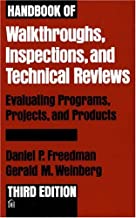(With Daniel P. Freedman)
* ISBN: 0-932633-19-6 ©1990 464 pages hardcover
Dorset House Publishing
(translated into Portuguese, Chinese)
The new revision of this highly successful handbook provides information on the hows and whys of performing and documenting formal technical reviews of systems and procedures in an easy-to-follow, practical question-and-answer format.
“a basic reference for anyone engaged in system design and programming activities.”
-Journal of Systems Management
“Anyone needing, planning, or attending a review or the like should have consulted this handbook to get them on the right wavelength for really useful, productive evaluations.” —C.C. Dilloway, Computer Books Review
“My favorite book on this topic . . .” —J. Adrian Zimmer, Editor, Journal of Software Maintenance
Full of Meat
“When I started reading Walkthroughs, Inspections, and Technical Reviews: Evaluating Programs, Projects, and Products by Daniel P. Freedman and Gerald M. Weinberg, my intention was to summarize its key points. But alas, I have found this talk impossible because every page of this book is so full of meat that the summary would be almost as long as the book itself. The book is based on the authors’ extensive experience in conducting, facilitating, and observing reviews, and I’m not surprised the book has been reissued and reprinted so many times. . . .” —Naomi Karten, Managing End-User Computing
No one has significantly bettered the Freeman & Weinberg approach.
In a worthwhile way deals more with the why than the how.
Inspections are intrinsically boring. Freeman & Weinberg don’t say this. Inspections are like going to the dentist. They don’t say this either. No one really wants to have their work scrutinised by others, but this book puts the case very well that one should, and that one shouldn’t mind. It deals sensitively with the principles to employ when reviewing the work of others and being able to continue working with them afterwards. If the culture of your organisation opposes the notion of formal technical reviews in practice if not in principle, but its products contain defects, then this book makes a good starting point. The Gilb & Graham book on inspections is much longer and more substantive, but no one has significantly bettered the Freeman & Weinberg approach. [email protected] from London, England
Highly recommended.
Written in a lively question and answer style the book covers thoroughly the philosophy and practice of group based technical reviews. I found their discussion of the relationship between effective project management and reviews to be particularly important – they emphasis that because reviews produce evidence of actual completion of a product (rather than claimed completion) they are an essential tool for assessment of milestone completion.
The question and answer style leads to some repetition. However on the positive side the answers always get to the very core of each issue. Rather than presenting prescriptive rules they clearly explain the rationale behind each technique so one can understand the contribution each makes to the objective of achieving an effective review.
Word of caution with regard to terminology – they use the term “Inspection” to mean a review where one restricts one’s attention to a few selected topics. This is regrettable because their description of “Formal Technical Reviews” is very close to the “Inspection” process as described in Tom Gilb’s book and in Michael Fagan’s classic article in IBM System Journal. Once this is understood this book and Gilb’s book on Inspection compliment each other very well.
Essential reading to anyone involved with Software Project Management. – [email protected] from Ireland
Contents
Part A: Introduction
Section 1: About This Handbook
Section 2: What Is a Formal Technical Review?
Part B: The Review Environment
Section 1: Selecting Reviewers
Section 2: Management Participation
Section 3: Allocating Time and Facilities for Reviews
Section 4: Notes on Getting Started
Section 5: Technical Reviews and Project Management
PART C: Conducting the Review
Section 1: The Review Leader
Section 2: The Recorder
Section 3: Helpful Rules and Customs for Reviewers
Section 4: Helpful Rules for Management
Section 5: The User and the Review
PART D: Reporting the Results of the Review
Section 1: Functions of Reporting
Section 2: The Technical Review Summary Report
Section 3: The Technical Review Issues List
Section 4: Technical Review Related Issue Report
Section 5: System History
Section 6: Writing Issues
PART E: Varieties of Review Disciplines
Section 1: Why There are So Many Review Variations
Section 2: The Walkthrough
Section 3: Inspections
Section 4: Round-Robin Reviews
Section 5: Review Teams
Section 6: A Collection of Review Tactics
Section 7: Informal Reviews
PART F: Types of Materials Reviewed
Section 1: Varieties of Reviews and Their Origins
Section 2: Functional Specification Reviews
Section 3: Design Reviews
Section 4: Code Reviews
Section 5: Documentation Reviews
Section 6: Test Plan Reviews
Section 7: Tool and Package Reviews
Section 8: Reviews of Training Materials and Plans
Section 9: Reviews of Procedures and Standards
Section 10: Operations and Maintenance Reviews
Section 11: Reviews in an Academic Environment
Section 12: Implementation of Structured Walkthroughs in the Classroom
Part G: Bibliography
Part H: Index

